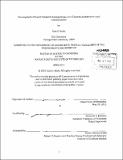Development of novel polymeric nanoparticles with tailored architectures and functionalities/
Author(s)
Burts, Alan O. (Alan Omar)
DownloadFull printable version (5.062Mb)
Other Contributors
Massachusetts Institute of Technology. Department of Chemistry.
Advisor
Jeremiah A. Johnson.
Terms of use
Metadata
Show full item recordAbstract
Developing a modular synthetic route to a combinatorial library of functional nanoparticles for applications like drug delivery is one of the main interests of our group. To this end, we have envisioned a novel nanoparticle architecture called a brush-arm star polymer (BASP), which has polymer brushes on the periphery shielding the core. Such nanoparticles were synthesized by, first, "graft-through" ring-opening metathesis polymerization (ROMP) of a norbornene-macromonomer to create the brush-arms, and second, cross-linking the arms with a bis-norbornene cross-linker to afford star polymers via the "arm-first" star polymer method. Functionality can be installed into the macromonomer (MM) or crosslinker preand post-polymerization. We took advantage of the highly efficient third-generation Grubbs catalyst to polymerize a polyethylene glycol (PEG) macromonomer (MM) and a bisnorbornene nitrobenzyloxycarbonyl (NBOC) photocleavable cross-linker to cross-link the brush-arms, which led to low-dispersity (Đ </=1.23) core-degradable BASPs. Controlled degradation of these star polymers was achieved by UV irradiation (365 nm). Next, a novel branched norbornene-polystyrene (PS)-polylactide (PLA)-MM was used to create pseudo-alternating copolymers and miktoarm-BASPs. Transmission electron miscroscopy (TEM) of these star polymers revealed nanoparticles with segregated domains. Also, new cross-linkers were explored containing two different bis-norbornene reversible addition-fragmentation chain-transfer (RAFT) agents. A more flexible RAFT initiator crosslinker led to high-dispersity (Đ >\=1.52) BASPs, while the more rigid RAFT initiator crosslinker led to low-dispersity (Đ </=1.05) BASPs. Finally, doxorubicin-loaded, photocleavable drug vector BASPs were synthesized from azide-functionalized BASPs. Copper-catalyzed azide-alkyne cycloaddition (CuAAC) was utilized to covalently link doxorubicin to the azide BASPs, post-polymerization. These BASPs degraded and simultaneously released their drug payload upon UV irradiation. MTT assays were conducted with these nanoparticles on MCF-7 human breast cancer cells and were shown to be non-toxic before UV irradiation and toxic afterward.
Description
Thesis (S.M.)--Massachusetts Institute of Technology, Dept. of Chemistry, 2013. Cataloged from PDF version of thesis. Includes bibliographical references (p. 41-47).
Date issued
2013Department
Massachusetts Institute of Technology. Department of ChemistryPublisher
Massachusetts Institute of Technology
Keywords
Chemistry.